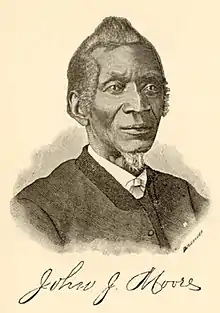
John Jamison Moore was an American preacher and educator.[1]
Moore's achievements include writing a history of the AME Zion Church, establishing the first AME Zion church and school in San Francisco, and advocating for African-American access to education and religion through his newspaper, The Lunar Visitor.[2]
Early life
Moore was born as a slave in what is today West Virginia. At age 15, he and his mother escaped to Philadelphia to live in freedom. [3] Moore soon became involved in the African American Churches in that city. He eventually became a prominent preacher at the AME Zion Church in Philadelphia.[4]
Moore also traveled to New York City to participate in activities at the AME Zion Church there. He wrote about this church in his book, The History of The AME Zion Church in America. Founded in 1796 in the City of New York.[5][6]
Life in San Francisco
In 1852, Moore moved to San Francisco to further the church in that city. According to Bishop B.J. Walls, Moore was credited with,
"Planting the core tenets of freedom, as practiced by his denomination, on the Pacific Coast, in 1852".[7]
In 1852 Moore founded St. Cyprian AME Church, the first AME Zion Church in San Francisco. Around that time, he established a school for African-American children in the church basement, serving as teacher and principal.[3] He created the school because African-American children were barred from public schools in San Francisco. That same year, Moore founded and became head editor of The Lunar Visitor.[8] According to The First AME Zion Church's website, the Lunar Visitor, "promoted civil rights and advocated developing institutions for educational, social and political skills useful in working toward a full participation in American Society,".[3] The newspaper was also "The only African-American magazine in the western part of the country," during the period it was being printed, according to Thomas Segady.[8]
Later life
Moore later moved to Salisbury, North Carolina, where he married Francis Moore.[3] He died on December 9, 1893, on the train home from a conference in Western North Carolina. He was buried in Salisbury..[3]
See also
References
- ↑ Coffman, Elesha (February 2001). "Marching to Zion". ChristianityToday.com. Retrieved 2018-12-12.
- ↑ Murphy, Larry G.; Melton, J. Gordon; Ward, Gary L. (2013-11-20). Encyclopedia of African American Religions. Routledge. pp. 504–505. ISBN 9781135513382.
- 1 2 3 4 5 "About Our Founder." First A.M.E Zion Church, San Francisco. 2017. Accessed November 19, 2018. http://www.firstamezionsf.org/about-our-founder%5B%5D.
- ↑ Morris, John (1977). "AME Zion Celebrates 125 Years". Sun Reporter (San Francisco, Calif.).
- ↑ Roff, Sandra (1985). "Researching The History of Blacks in New York State". Afro-Americans in New York Life and History. 9: 43.
- ↑ Moore, John Jamison (1884). The History of The AME Zion Church in America. Founded in 1796 in the City of New York. York, Pennsylvania: Teacher's Journal Office.
- ↑ "Ministers, Laymen Meet: Zion Bishops Council Keys Call to Freedom". New Pittsburgh Courier. January 25, 1964.
- 1 2 Segady, Thomas and, Berardi, Gayle (1991). "Community Identification and Cultural Formation: The Role of African-American Newspapers in the American West". The Griot. 10: 13–19.
{{cite journal}}: CS1 maint: multiple names: authors list (link)